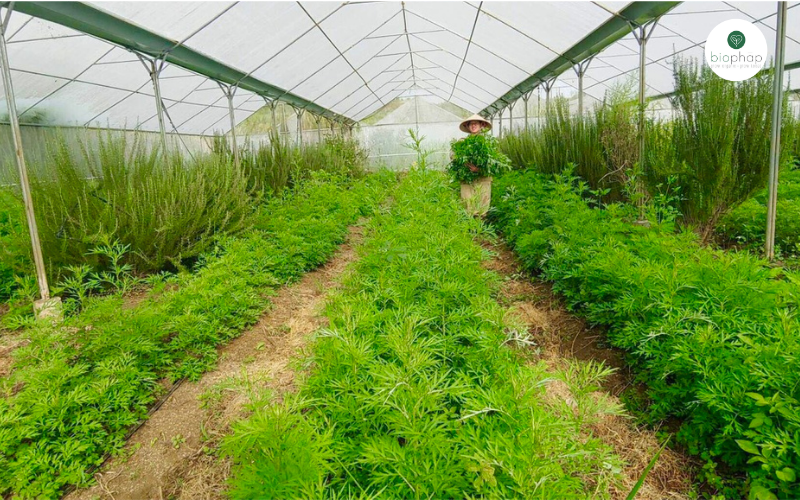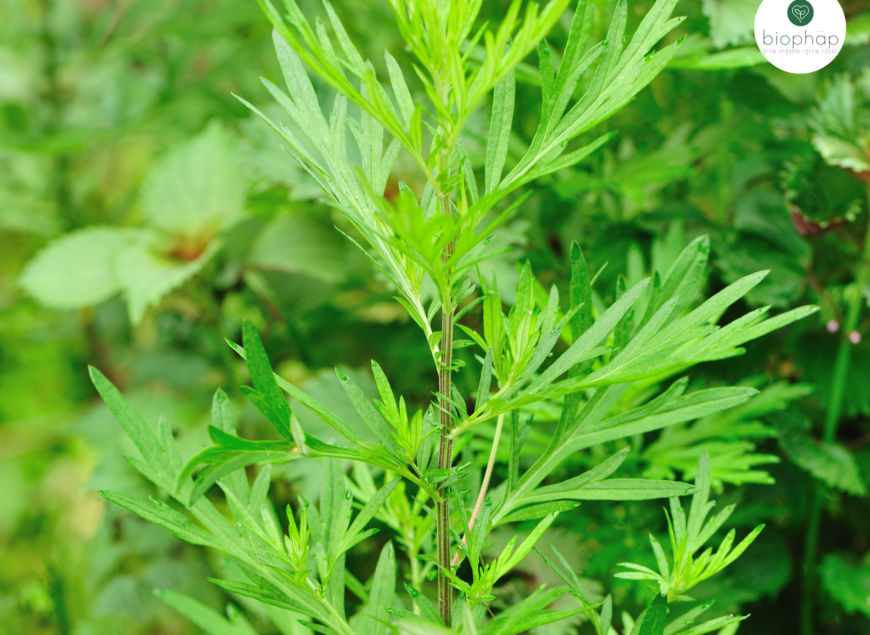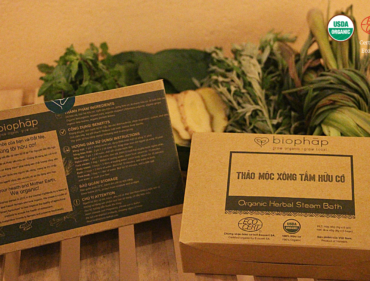Vegetables are not only a kind of food used for daily eating but also have (more or less) use in the prevention and treatment of diseases for us. And artemisia is a plant that is included in the list of vegetables by BIOPHAP to diversify for consumers because of its excellent healing properties. Currently, Artemisia is being planted by us at Mang Canh farm – one of the internationally certified organic farms in Kon Tu Rang Village, Mang Canh Commune, Kon Plong District, Kon Tum Province.
I. WHAT IS THE ARTEMISIA?
Artemisia is also known as medicinal plants, common name is mugwort. Artemisia has the scientific name Artemisia vulgaris L. Asteraceae (Compositae).
1.Identifying characteristics
Artemisia is a perennial grass, 50-60cm tall, with a large stem with longitudinal grooves. Leaves alternate, broad without stalks (but lower leaves often have stalks), lobed feathers, leaf color on 2 sides is very different: The upper surface is dark green, the lower surface is ash white due to a lot of white small hairs. Flowers grow in double panicles consisting of many head-shaped inflorescences.

2.How to grow artemisia
1.1 Planted with cuttings:
Plant in the early morning or late afternoon.
Plug the prepared seedlings into the ground (can be installed straight or inclined) Depth of 3-5 cm.
Can plant 1 tree / cluster (if the cuttings are healthy), or 2 plants /cluster (smaller cuttings)
Then carefully compress the cuttings and level the ground around the newly planted cuttings.
Finally, watering right after planting so that soil cling to the cuttings and fertilizer soaks into the bed.
1.2.Planted with seeds
The seeds can be sown directly on the bed or the seedlings are planted and then planted will ensure that the plants germinate and grow well – more evenly.
Sow the seeds directly on the bed in rows about 25 cm apart. After the tree reaches 1-2 pairs of real leaves, pruning the seedlings in places that are too thick to ensure a suitable distance for plants to grow and develop.
Watering regularly 2 times / day: morning and afternoon to cool to germinate well.
II. NUTRITIONAL COMPOSITION AND HEALING PROPERTIES OF MUGWORT
2.1 Nutritional composition in 100 grams of Artemisia leaves (1) (2)
Calories: artemisia helps replenish energy up to 46cal
Protein: Reduces the risk of cardiovascular diseases. A diet rich in plant protein will help lower blood pressure and reduce bad cholesterol in the blood. The amount of protein in artemisia accounts for 5.2g.
Fatty acid: prevents the absorption of cholesterol in the small intestine, reducing the amount of cholesterol entering the blood from daily food. Fatty acid is around 0.3g
Carbohydrates: Participate in the body’s functions: immunity, reproduction, nutrition and metabolism, nervous system activity, red blood cell formation. Carbohydrates is arounf 8.7g.
Fiber: In artemisia also contains a lot of fiber, although it is not a nutrition because this substance is not absorbed by the body, it has a mechanical role: helps the intestines excrete residues in food, cures apples. constipation, prevent gallstones and rectal cancer. Fiber is around 3.5g
Vitamins and minerals: have a positive effect in the metabolism of substances in the activity of the endocrine glands, preventing obesity, atherosclerosis and many other diseases. Vitamins and minerals is around 2g
2.2 Healing properties of Artemisia (3)(4)
Flavonoids: have anti-inflammatory and analgesic effects. Flavonoids also help the body maintain bones and teeth and produce collagen protein most efficiently so that it can create blood vessels and muscle tissue. Flavonoids also have an extremely powerful antioxidant role. In addition, this group of substances also helps the immune system to prevent and reverse oxidative stress.
Cineole: This active ingredient has the ability to loosen mucus, help the airways open, and has the effect of reducing pain and reducing swelling at the contact site. So Cineol is often used and plays an important role in cough medicines, other respiratory symptoms and mouthwashes.
Adenine: supports nerve muscle activity, helps strengthen antibodies against infections, supports blood sugar balance and strengthens the immune system
Choline: An essential nutrient for the normal functioning of the body such as liver function, brain development, muscle movement, metabolism and central nervous system activities.
Thujone: has a euphoric effect, but taking a lot (more than 0.23 mg thujone/pound (0.5 mg/kg), threshold for alcoholic beverages like artemisia wine is 16mg/pound (35 mg/kg)) can can cause insanity (in overdose, it causes the central nervous system to be overexcited, leading to tremors in the limbs, then local or systemic convulsions)
III. HOW TO USE ARTEMISIA?
In acupuncture: helping to support muscle and joint pain, spinal degeneration …
In massage therapy: Using artemisia as essential oil, helps relieve limb pain, joint pain, enhances blood circulation…
In food: Using artemisia as a healing dish, helps relieve abdominal pain, enhances blood circulation to the brain, relieves pain caused by rheumatism, supports pregnancy, etc. In addition, artemisia water also has a conditioning effect. Menstruation for women, cough, flu, sore throat, headache…
In beauty: Using fresh artemisia leaves on the face will help treat pimples, rashes. Using dried artemisia leaves to steam your face or take a bath helps blood circulation, nourishes the skin, retains moisture for the skin, makes the skin softer and smoother.
In Oriental Medicine: Using artemisia to make essential oil, decoction or in combination with other oriental medicinal herbs to make extremely effective remedies for common ailments such as regulating menstruation, treating coughs or colds Influenza due to cold, treatment of anorexia, weakness, reduce acne, beautify the skin … artemisia leaves crushed, applied to the wound will help stop bleeding, heal faster. Artemisia is also used by many people for steaming because it is effective in clearing the meridians, nourishing life, increasing immunity …
In daily life: Use artemisia as essential oil to scent the room, clean the air, avoid allergies and respiratory diseases…

IV. WHY YOU SHOULD BUY BIOPHAP’S ARTEMISIA?
The farmers at Biophap offer you the following quality artemisia:
- Organic: artemisia is grown according to international organic standards: EU (European Union), USDA (US Department of Agriculture) controlled and certified by the ECOCERT certification agency.
- Temperature: artemisia is grown under mild and cool weather conditions of the Central Highlands, the average temperature is in the range of 20-25 degrees Celsius, the cold nights and short days help artemisia develop medicinal properties. material with high nutritional content.
- Soil: The soil for planting artemisia must be guaranteed for 3 years without using synthetic chemicals, and have been tested at reputable centers to ensure the nutritional criteria of the soil and metals.
- Water: The quality of water for artemisia is always tested periodically and takes advantage of rainwater, well water and drip irrigation systems to help artemisia absorb more nutrients and grow better and reduce pests and diseases.
- Varieties: Our artemisia is not a genetically modified organism.

Each vegetable used more or less has the effect of preventing or treating disease. Know which vegetables are useful to eat regularly, which vegetables should be eaten seasonally, which are suitable for the state of the body to have a good use plan. Artemisia is not only a vegetable but also a valuable medicinal plant, so remember to add artemisia to your family’s menu sometime.
For more information on BIOPHAP’s other products, please visit:
- List of organic fruits and vegetables: Vegetables
- List of organic fresh fruit: Fruits
- List of herbs and spices: Finished Products and Semi products
#BIOPHAP #Climate_Smart_Agriculture #Agroforestry #Biodiversity #Smart_Farmer #Organic #EU #USDA #Fair_for_Life #artemisia #crops_and_health
Source:
- https://lavierebelle.org/IMG/pdf/2009_nutritional_characterisation_and_antioxidant_capacity_of_different_tissues_of_artemisia_annua_l.pdf
- https://slism.com/calorie/106301/
- https://www.healthline.com/nutrition/what-is-wormwood#dosage-safety
- Significance of Artemisia Vulgaris L. (Common Mugwort) in the History of Medicine and Its Possible Contemporary Applications Substantiated by Phytochemical and Pharmacological Studies (nih.gov)
Other articles:
- Positive farmer during lockdown Covid-19
- International Mother Earth Day April 22, 2021 – SMALL ACTION BUT MEANINGFUL
- BAMBOO SHOOT AND DUCK VERMICELLI SOUP








